Trading Using AI is changing how people trade, yet the flood of platforms, bold claims, and technical choices can leave you unsure where to start. Which platform fits your plan: one built for algorithmic trading with robust backtesting and API integration, or one focused on machine learning models, signal generation, and portfolio automation? This article breaks down the best software for automated trading, highlighting trading bots, strategy optimization, execution speed, broker connectors,s and risk controls so you can gain a clear understanding and confidently select the best technology.
Trading Bot Experts' best trading bots offer clear comparisons, real-world test results, and plain guidance to help you pick the right automated strategy, manage risk, and connect to your broker.
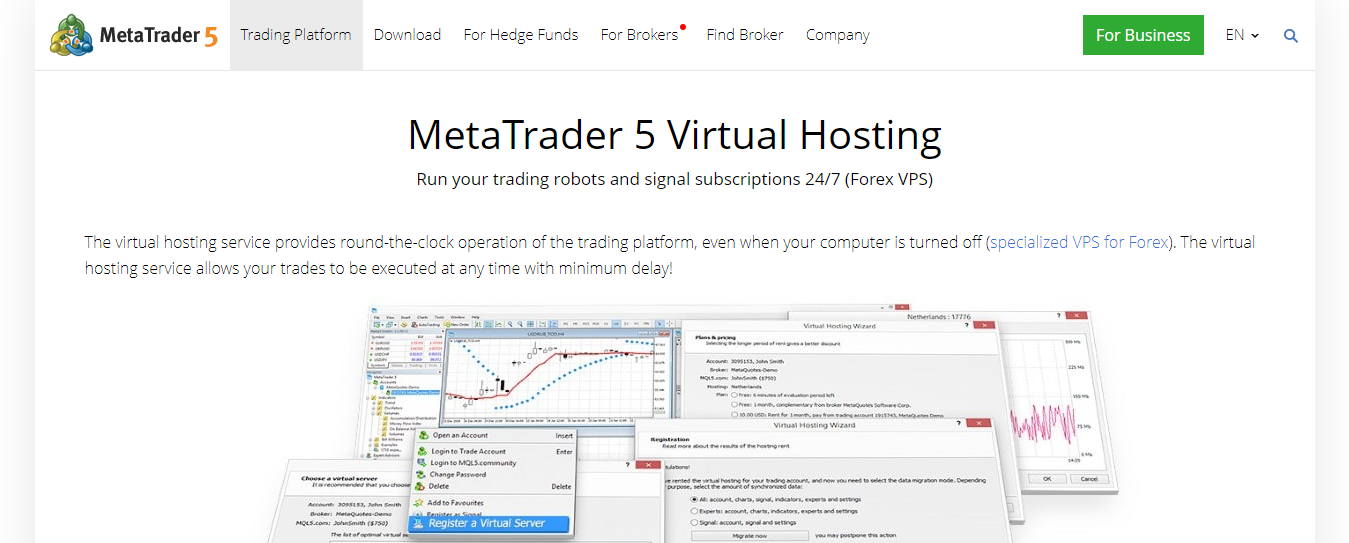
MetaTrader 5 (MT5) is a versatile and widely adopted automated trading platform designed for both novice and experienced traders. It supports rule-based automation through its proprietary MQL5 programming language, allowing users to create or use Expert Advisors (EAs) that trade on their behalf. MT5 is renowned for its advanced charting tools, comprehensive backtesting capabilities, and compatibility with a broad range of brokers, making it a go-to solution for forex and CFD trading.
MT5’s robust foundation supports multi-asset trading, including forex, indices, commodities, and CFDs. Its high level of customization, combined with a large community of traders and developers, makes it suitable for users looking to automate and enhance their trading strategies systematically.
Extensive broker support and liquidity.
Large and active user community.
Powerful backtesting and optimization tools.
Free access through many brokers.
Highly customizable for developers.
Steeper learning curve for users unfamiliar with MQL5.
Complex interface for total beginners.
Limited direct support for non-forex markets compared to some competitors.
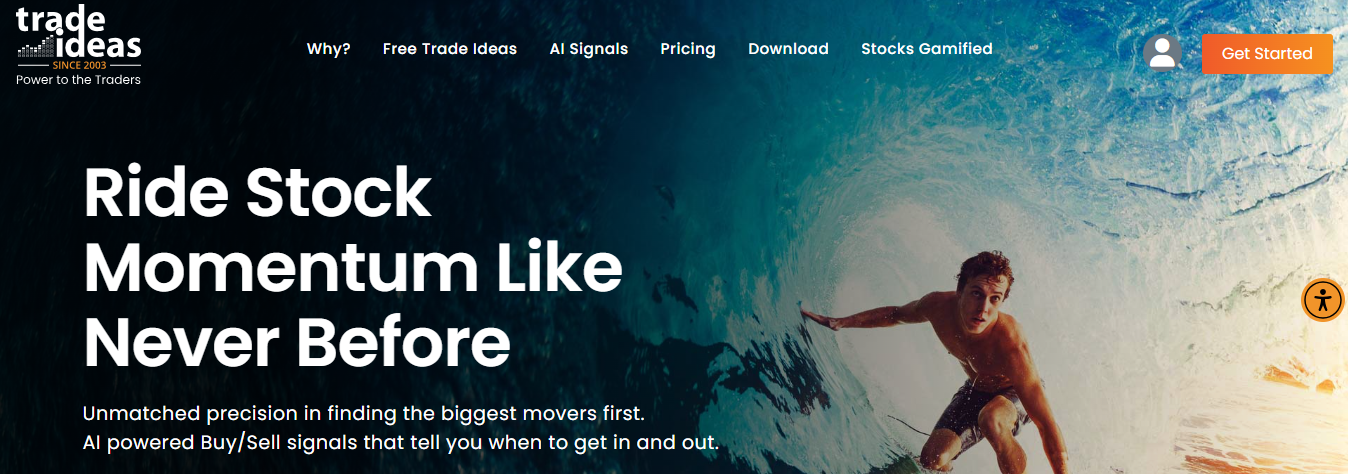
Trade Ideas is an advanced AI-driven trading platform mainly used for stock market trading. It leverages artificial intelligence to generate real-time trade signals, helping traders identify promising opportunities quickly and efficiently. The platform provides simulated trading environments, comprehensive backtesting (with its OddsMaker tool), and extensive analytics designed to enhance decision-making.
Best suited for advanced traders seeking AI-powered insights, Trade Ideas boasts an intuitive interface and supports extensive customization of AI parameters to match various trading styles. However, its premium pricing may deter casual or part-time traders.
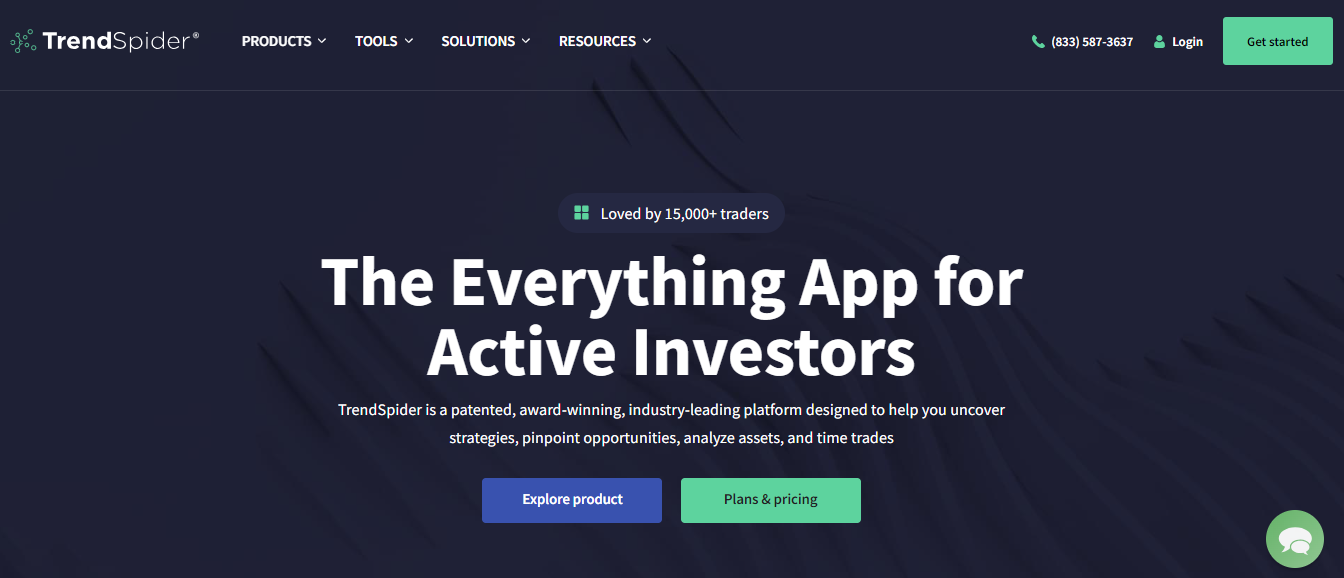
TrendSpider is an automated technical analysis platform designed to simplify complex charting and strategy testing without needing programming knowledge. Its multi-timeframe analysis, dynamic alerts, and no-code strategy tester help traders identify trends and opportunities quickly. TrendSpider also offers AI-driven technical analysis, providing enhanced pattern recognition for stocks and forex.
This software is targeted at traders who want rigorous charting and technical tools but prefer not to write code. While it excels at analysis, it does not provide direct brokerage execution, so users must place trades elsewhere.
No direct brokerage integration or trade execution.
Subscription pricing may be expensive for part-time traders.
Advanced features require higher-tier plans.
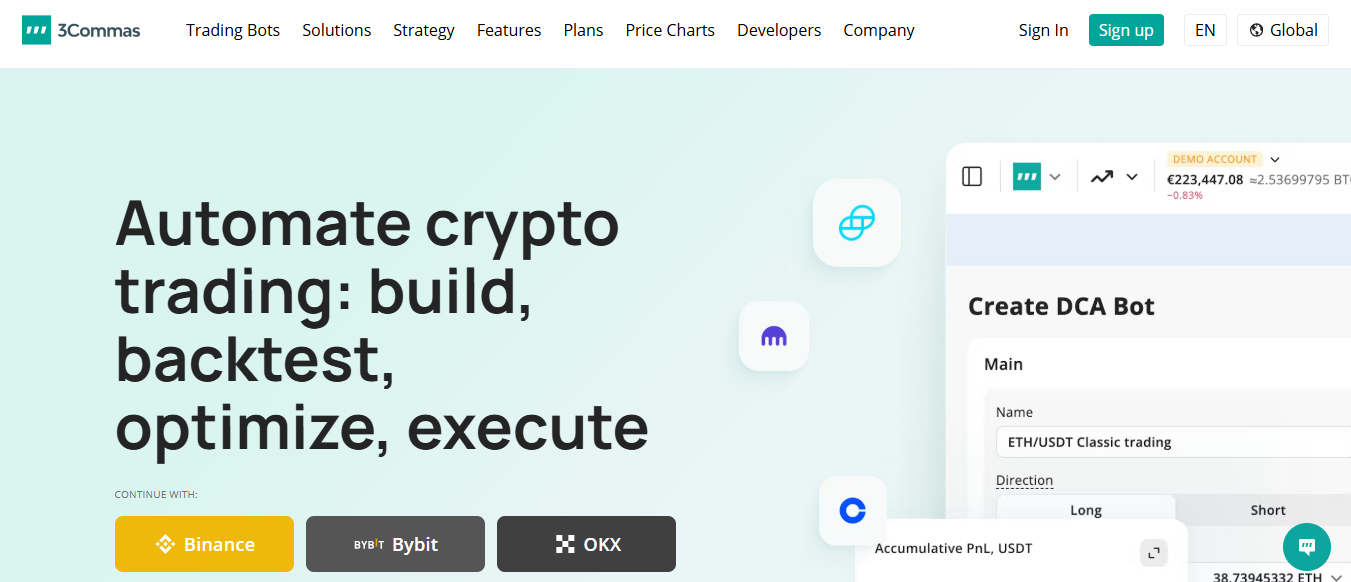
3Commas is a cryptocurrency-focused automated trading platform offering a wide array of smart trading bots, including DCA (Dollar Cost Averaging) bots, grid trading, and options automation. It also provides portfolio analytics and a social copy-trading marketplace where users can follow and automatically replicate trades from experienced traders.
Ideal for experienced crypto traders, 3Commas offers an extensive degree of strategy customization and risk management tools. Its security features are robust, giving users confidence when trading volatile crypto assets.
Comprehensive toolset for crypto trading.
Supports many popular cryptocurrency exchanges.
High customization and risk control.
Strong community and copy-trading options.
Good security practices.

QuantConnect is a cloud-based algorithmic trading platform catering mainly to algorithm developers and quant traders. It offers powerful backtesting capabilities, live trading support, and access to institutional-quality market data across multiple asset classes, including stocks, options, futures, and forex.
QuantConnect appeals to programmers with experience in C# and Python, enabling full customization of trading algorithms. Its open-source nature and strong developer community make it a flexible and advanced tool, albeit with a steep learning curve for non-programmers.
.webp)
Automated trading software, also known as algorithmic trading or trading bots, is a type of computer program designed to execute trading orders such as buying and selling assets in financial markets automatically. It operates based on a predefined set of rules or algorithms that traders input, allowing the software to make trading decisions without human intervention. This automation helps to eliminate emotional bias and enables trades to be carried out swiftly and continuously.
At its core, automated trading software translates trading strategies and criteria into precise instructions that the program follows. These instructions can be based on technical analysis indicators, statistical models, or other market data parameters. The program constantly monitors the market for conditions that meet these rules, and when these conditions are met, it executes trades instantly. This helps traders capitalize on fleeting market opportunities that would be difficult or impossible to exploit manually.
The software is typically connected directly to a brokerage account or trading platform, allowing it to place, manage, and close orders seamlessly. The design often integrates sophisticated mathematical models and can analyze multiple assets and indicators simultaneously. Many platforms provide programming languages specific to algorithmic trading, such as MetaQuotes Language (MQL) for MetaTrader, enabling users to code custom strategies or use prebuilt ones with little to no programming experience.
Automated trading software often requires knowledge of specific programming languages to create, customize, or understand trading algorithms effectively. Common programming languages used in this field include Python, known for its simplicity and powerful libraries for data analysis and machine learning. MetaQuotes Language (MQL) is widely used for developing automated trading systems on the MetaTrader platform. Other popular languages include C++ and Java, valued for their performance and speed in executing high-frequency trading strategies. Additionally, R is sometimes used for statistical analysis and backtesting trading strategies.
Grasping these programming languages allows traders and developers to tailor their automated trading software to specific strategies, integrate with various trading platforms, and optimize performance under live market conditions.
Trading Bot Expert is a valuable resource for traders seeking personalized guidance on selecting the best trading bots. They offer tailored recommendations based on a trader’s experience level and budget, helping users find automated trading solutions that fit their unique needs and maximize their trading potential.
Want help picking the right bot? Not sure which trading bot is right for you? Take our free Trading Bot Match Quiz and get a personalized recommendation based on your budget, goals, and risk tolerance — in under 60 seconds; we’ll also send you a free e-book with honest reviews, performance stats, and red flags to avoid when comparing the best trading bots.

A well-designed interface is crucial, especially for beginners. The software should offer intuitive navigation, clear layouts, and easy access to essential functions. This allows traders to set up and manage their strategies without unnecessary complexity or steep learning curves.
At its core, effective software must enable fully automated execution of trades based on user-defined parameters. The platform should support conditional rules like "if X happens, then do Y," allowing trades to be executed instantly without manual intervention. This removes emotional biases and ensures trades happen at optimal moments.
Backtesting allows users to test their trading strategies against historical market data to evaluate their effectiveness before deploying them live. While past performance does not guarantee future results, this feature provides valuable insights and helps refine strategies to improve potential outcomes.
Access to live market data and the ability to execute trades in real-time are vital. Automated systems often execute trades within milliseconds, which is essential in volatile and fast-moving markets to capitalize on price movements before they change.
Top-tier software supports customization, enabling traders to build or tweak algorithms to suit their unique trading strategy. Whether through simple rule-based settings or advanced programming languages like MQL5, customization ensures the platform adapts to various trading styles and strategies.
The ability to trade across multiple asset classes, such as forex, stocks, commodities, and indices, from a single platform enhances versatility. This broad market access allows traders to diversify and seize opportunities in different sectors.
Automated trading involves risks, so software should include robust risk controls:
Stop-loss and take-profit orders to automatically limit losses and secure gains.
Trailing stops that adjust dynamically with favorable price movements.
Risk calculators to help assess potential exposure before trades are placed.
Since trading involves real money and sensitive information, security is paramount. Look for platforms regulated by recognized authorities (e.g., FCA, SEC, CySEC) to ensure trustworthy operations. Additional security features such as data encryption, two-factor authentication, and fund segregation significantly reduce the risk of fraud or data breaches.
A dependable platform should operate smoothly without frequent crashes or downtime, especially during volatile market conditions. Reliable software minimizes execution errors and slippage, ensuring trade accuracy and consistency.
Responsive customer support is essential for resolving technical issues promptly. Additionally, an active user community or educational resources can help traders leverage the software’s full potential.

Backtesting is the process of evaluating a trading strategy by applying it to historical market data to see how it would have performed in the past. By simulating trades based on specific rules, traders can analyze whether their algorithms or strategies are likely to be profitable and robust before real money is involved. This method is fundamental to validating the effectiveness of trading models.
Here are the reasons why backtesting is important:
Backtesting confirms whether a trading strategy works under historical market conditions. It helps verify if the rules embedded in automated software are sound and capable of generating consistent returns. This validation builds trust in the strategy's implementation, reducing guesswork.
Through backtesting, traders can objectively measure key metrics such as win rate, average returns, drawdowns, and risk-adjusted returns. These metrics reveal strengths and weaknesses of the strategy, guiding improvements and refinements.
Testing strategies on past data allows traders to understand their risk exposure, including potential maximum losses and volatility. This helps set proper stop-loss limits and optimize position sizing to protect capital.
Backtesting facilitates tweaking of strategy parameters like entry and exit points, stop losses, and trade size to find optimal settings. This ensures the strategy adapts well to market dynamics while managing risk.
By observing favorable backtesting results across diverse market environments, traders gain confidence in their strategies. This confidence promotes disciplined execution and helps avoid impulsive decisions driven by emotions.
Historical analysis through backtesting uncovers market trends and recurring patterns that can be exploited. This insight aids in developing better-informed trade algorithms aligned with prevailing market conditions.
Automated trading relies heavily on pre-programmed rules to execute trades mechanically. Backtesting ensures these programmed rules are tested realistically, reducing the likelihood of unexpected losses. It also enables the fine-tuning of automated systems by simulating how they would behave during different market phases.
In addition, backtesting software often comes with features that allow traders to simulate trading costs, slippage, and other real-world trading conditions, providing a more accurate representation of performance.
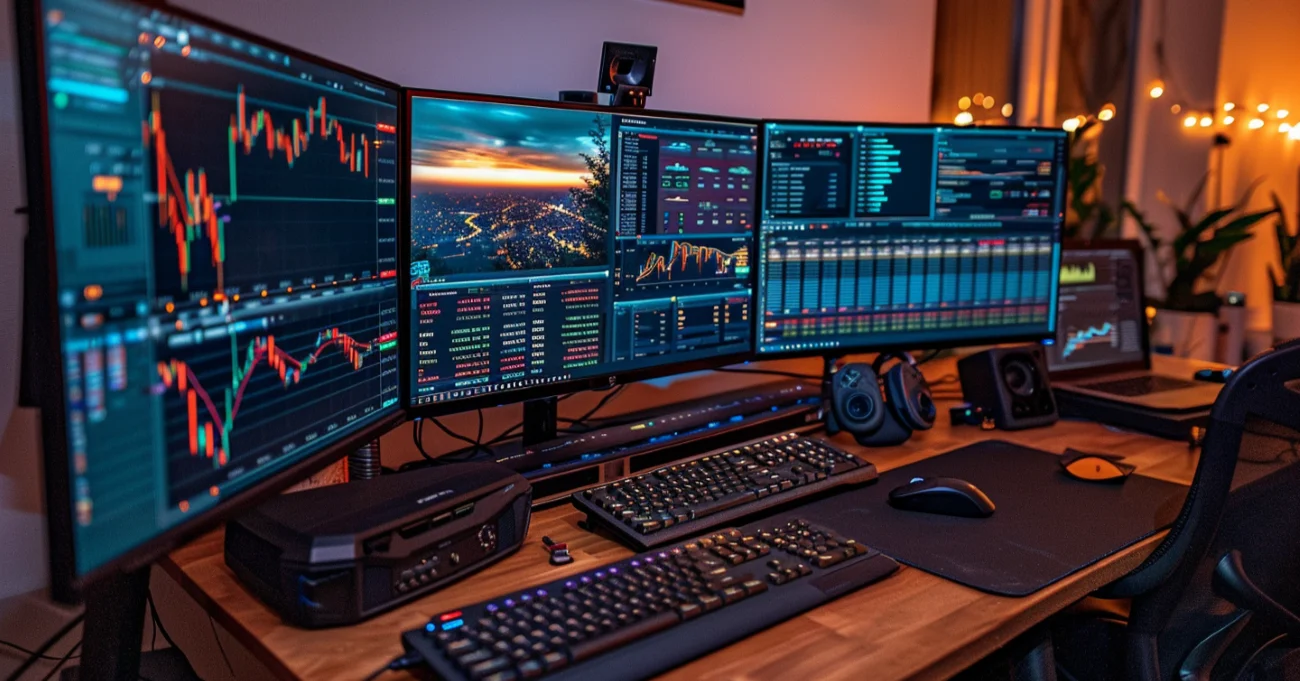
Equity markets, representing shares of ownership in companies, are one of the most popular asset classes for automated trading. They make up a significant portion of global market capitalization and provide a structured environment ideal for algorithmic strategies. Trading algorithms here focus on parameters like timing, price, and volume, often with solid backtested strategies to manage risks effectively. For beginners, equities serve as an excellent entry point due to their clear trading rules and abundant historical data.
Commodities trading has seen rapid adoption of automated systems, especially in futures markets. These include precious metals, energy resources like oil, and agricultural products. The commodity sector demands algorithms that can adapt to both local and global economic events, such as overnight price fluctuations or government policy changes affecting supply and demand. Automated trading offers advanced tools for hedging and quick execution in these highly dynamic markets.
The Forex market, characterized by high liquidity and 24-hour trading, is another key asset class for automated trading. Algorithms here are designed to capitalize on currency pair price movements, using technical indicators and trend-following logic. The rapid movement of currency prices fits well with automated strategies that can monitor the market continuously and react instantly.
Derivative markets, including options and futures, benefit from algorithmic trading by enabling complex strategies such as arbitrage, market making, and hedging. These instruments often require precise timing and rapid execution, making automation advantageous. Algorithmic systems handle statistical models and real-time data to manage risk and optimize trade entry and exit points effectively.
Although traditionally less dominated by automated systems, bond markets are increasingly incorporating algorithmic trading. Automation enables fast processing of large volumes and enhances liquidity. Algorithms in bond trading often focus on optimizing execution strategies rather than speculative trading due to the nature of the asset class.

Automated trading systems execute orders in milliseconds, using low-latency trading techniques and direct API trading to shave execution time. Algorithmic trading software routes orders to the best venues, manages order execution strategies, and uses colocated servers or VPS for trading to cut network lag. Trading bots keep consistent timing across entry, exit, and scaling actions so you can target tiny price moves that vanish for manual traders. High-frequency trading shops and retail algorithmic traders both rely on trade execution speed as a core performance input.
Rule based algorithms apply pre-defined strategies without hesitation, removing fear and greed from trade decisions. Automated trading systems follow signal generation logic and position sizing rules the same way on every trade, which improves reproducibility and auditability. When a robo advisor or custom bot receives a signal, the system places orders and records the rationale so you can review edge and failure modes later. Do you want discipline baked into every trade?
Cloud based platforms and exchange APIs let automated platforms scan global markets around the clock, which matters most for crypto and overseas exchanges that never close. Scheduling, continuous monitoring, and alerting combine with VPS or cloud instances to keep strategies live across time zones. That means your quantitative trading software can hunt for setups, manage risk, and rebalance portfolios without human presence at the keyboard. You gain reach into more assets and session overlaps.
A robust backtesting engine uses historical tick and minute data to estimate strategy performance and detect curve fitting. Algorithmic trading platforms offer walk-forward testing, Monte Carlo analysis, and parameter sweeps so you can evaluate robustness across market regimes. Use simulated execution models to include slippage and realistic order fills, then forward test on a paper account before funding a live broker integration. The process surfaces weaknesses and helps refine customizable strategies.
Automated risk management tools implement stop loss, take profit, dynamic position sizing, and portfolio-level drawdown controls with exact rules. Trade automation handles partial fills, trailing stops, and scaling out while keeping risk per trade within your target percentage. Integration with broker APIs allows immediate order cancellation or hedge execution when thresholds trigger, and portfolio automation can shift exposure across strategies to manage total risk. The system enforces limits without hesitation.
Trading automation tools run multiple strategies over many symbols and exchanges simultaneously to spread sources of return. Algorithmic platforms can route orders to different brokers, rebalance across asset classes, and run distinct models for equities, futures, FX, and crypto in parallel. That lets you build a portfolio of independent signals, reduce idiosyncratic risk, and capture asymmetric opportunities as they appear across markets. Software manages correlations and exposure at scale.
Cloud-based and on-premises execution engines scale compute and storage so you can run dozens of strategies and heavy backtests in parallel. Quantitative trading software and trading bots handle order volumes without human bottlenecks, and modular codebases let you add features like machine learning trading models or new signal generators quickly. API first designs and broker integration layers let teams iterate and deploy faster while keeping latency and reliability under control. Resources expand as the number of strategies and data needs rise.

One significant risk is over-optimization or curve-fitting, where trading algorithms are tailored too precisely to historical market data. Though this may produce excellent backtesting results, these systems may fail to adapt to real-world, dynamic market conditions, especially during unexpected events or high volatility, leading to poor performance and financial loss.
Automated trading systems rely heavily on technology, including software, hardware, data feeds, and internet connectivity. Any malfunction, such as software bugs, server outages, or network disruption,s can prevent trades from being executed at critical moments, potentially causing unintended trades or missed opportunities. This vulnerability underscores the need for robust monitoring and backup protocols.
The complexity of some automated systems, incorporating numerous technical indicators and decision rules, can make it difficult for traders to understand why a trade was executed. This lack of transparency hampers oversight and complicates troubleshooting and refinement of trading strategies.
High-frequency trading algorithms, a subset of automated trading, can amplify market volatility by executing numerous trades within fractions of a second. Such rapid-fire trading has been implicated in events like the 2010 Flash Crash, where markets plunged sharply due to cascading automated sell orders. This exemplifies how automated trading can sometimes destabilize markets.
The accuracy of automated trading heavily depends on the quality and timeliness of the data fed into the system. Erroneous or outdated data can cause flawed trading decisions, leading to unexpected losses. Ensuring data integrity through reputable sources and regular verification is essential.
Developing or acquiring high-quality automated trading software is often expensive, reflecting the complex expertise required. Additionally, systems require ongoing maintenance and updates to adjust strategies based on changing market conditions. For newcomers, the technical demands and costs involved may outweigh the benefits.
The market is rife with promoters selling supposedly profitable automated trading systems at suspiciously low prices. Many of these are scams promising unrealistic returns without credible proof. Traders should exercise caution by thoroughly researching products, checking for free trials, and relying on trusted reviews before investing.
Automated systems execute trades strictly according to their programming and cannot react intuitively to breaking news or geopolitical developments. Unlike human traders who can interpret and respond flexibly, automated systems may struggle during periods of unexpected market shocks.

Not sure which trading bot is right for you? Take our free Trading Bot Match Quiz and get a personalized recommendation in under 60 seconds. The quiz asks about budget, time horizon, trading goals, experience level, and risk tolerance, then maps your answers to algorithmic trading software and automated trading platforms that fit your profile. You get a clear match to options that support backtesting, strategy optimization, API integration, order execution, and risk controls so you can move forward with confidence.
Which features should the best software for automated trading include for your needs? The quiz highlights practical trade-offs: flexibility versus ease of use, cloud-based versus local execution, latency requirements, cost of licensing, and whether the system supports machine learning trading or classic quantitative strategies. You receive a ranked set of choices so you can compare execution quality, backtesting fidelity, live trade performance, and vendor transparency.
Click here to take the quiz and get your free report. You will receive a concise recommendation and a free e-book that lists honest reviews, performance stats, and red flags to avoid in the trading bot world. The e-book covers algorithmic trading software comparisons, API compatibility, broker connectivity, data feed quality, and practical setup tips for demo testing.
How do we pick reliable automated trading platforms? We test for consistent live trade history or verifiable simulated results, robust backtesting with walk-forward analysis, clear risk management features like stop loss and position sizing, and clean API documentation for brokers. We also check support quality, update cadence, and user feedback so you know whether the provider stands behind their product.
Are you after passive income or advanced model-driven performance? For hands-off profits, we recommend vetted robo-style bots that automate portfolio rebalancing and signal following with simple controls. For high-performance AI systems, we look for platforms with model training, feature engineering, live risk filters, and capacity for low-latency execution. Each path has different monitoring needs and capital requirements.
Take the recommended software and run it in a paper trading or demo account first. Backtest strategies on out-of-sample data and run a walk-forward test to spot overfit models. Monitor slippage and execution latency. Start with small capital and predefined risk limits, then scale methodically as live performance matches expectations.
What data feeds does it use, and can you audit them? How does the provider calculate performance metrics? Does the platform allow custom strategy scripts or only preset templates? What are the real-world costs, including fees and broker commissions? Which risk controls are enforced by the software rather than left to the user?
Seek transparent trade logs, third-party verified performance, detailed failure mode notes, and responsive technical support. Platforms that provide sandbox environments and full API docs reduce integration surprise and speed deployment.
The free e-book in our report contains side-by-side performance tables, feature checklists, and a checklist of warning signs for vendors that overpromise. Use it to shortlist software, set up objective evaluation criteria, and avoid common traps like poor data hygiene and hidden execution fees.
Want a tailored path forward? Take the free Trading Bot Match Quiz now and get a personalized recommendation plus a free e-book with honest reviews, performance stats, and red flags to avoid in the trading bot world. Click here to take the quiz and get your free report.